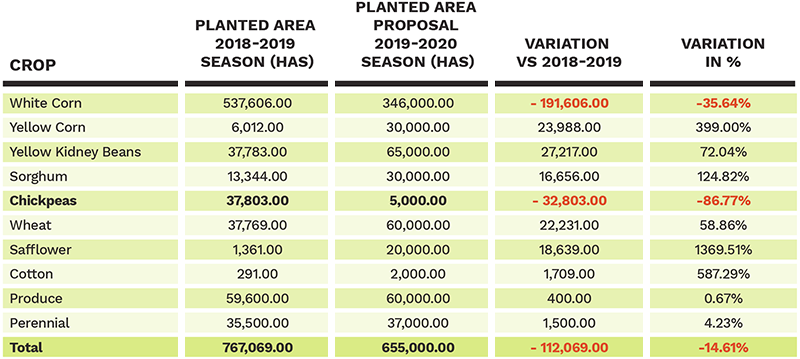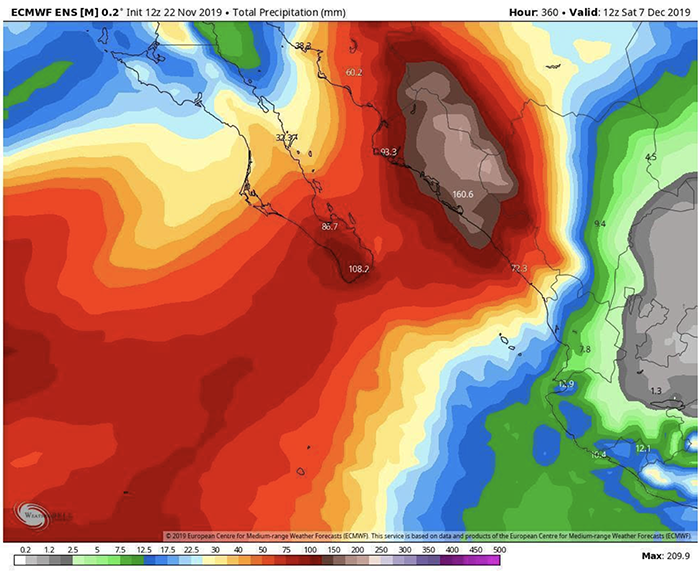November 29, 2019
Mexico has two growing cycles: the spring-summer cycle, when practically all of Mexico’s dry beans are grown, and the fall-winter cycle, when its chickpea crop is produced together with a smaller dry bean crop than in the spring-summer cycle.

During this cycle, dry beans are mainly grown in the states of Zacatecas, Durango and Chihuahua. The major bean classes produced are pinto, black and colored beans.
Harvest is presently underway, with some sources pegging progress at 15 to 20% while others say it is past the halfway mark. All sources agree, however, that farmers are holding onto new crop beans in hopes of better prices.
Production is expected to decrease as fewer hectares were seeded to beans this year and drought conditions during planting and crop development likely impacted yields. In 2018, the spring-summer dry bean crop amounted to 850,000 MT, but this year it is expected to total around 450,000 MT.
Additionally, rains delayed harvest and may also have damaged some grains. The crop quality rated 30% good, 50% regular and 20% poor.

During this cycle, a smaller dry bean crop is grown in the states of Sinaloa, Sonora and Nayarit. But more importantly, Mexico’s famed large caliber kabuli chickpeas are grown in Sinaloa, Sonora and Baja.
In Sinaloa, the dry bean planting has concluded. The initial expectation was that the production problems in Zacatecas, Chihuahua and Durango during the spring-summer cycle would see 100,000 hectares seeded to dry beans this year, but plantings ended up at around 50-60,000 hectares. The discrepancy is due to three main factors:
The intention to plant more dry beans was there, but these conditions made it too difficult for growers to follow through.
In Sinaloa, the chickpea crop is being seeded. The planting window for chickpeas runs through December 10. Chickpeas planted after that date are at an elevated risk of frost. This fall-winter cycle the planting intention was low because last year chickpea prices hit their lowest point in a decade. In 2018, growers had difficulty selling their crops and experienced payment delays of two to three months. Financing was also limited this year, as both private and state financial institutions did not finance chickpea seeding. There is no official estimate on the planted area at present, but agricultural authorities have suggested 5,000 hectares were planted in Sinaloa. The final seeded area will likely be higher, but nonetheless this reveals that there is no interest in chickpea production across the value chain—growers, authorities, elevators and financial institutions.
Across all of Mexico, the chickpea seeded area projection for this year is 50,000 hectares or less, which compares to 75,000 hectares in 2018 and 150,000 hectares in 2017.



Heavy rains forecast from November 26-28 could seriously damage bean crops and bring chickpea planting to a premature end.
A tropical system has begun to form off the southeast coast of Jalisco and is expected to interact with a cold front and a mid- to high-level jet stream, increasing the chances of widespread heavy rains, which could affect the growing area, dumping 10-30 mm of moisture starting Tuesday afternoon. Presently, there is an 80% chance of 100-200 mm of moisture over this period.
This is a developing story and the the GPC will follow-up on the impact of the heavy rains in the next few days.

Disclaimer: The opinions or views expressed in this publication are those of the authors or quoted persons. They do not purport to reflect the opinions or views of the Global Pulse Confederation or its members.